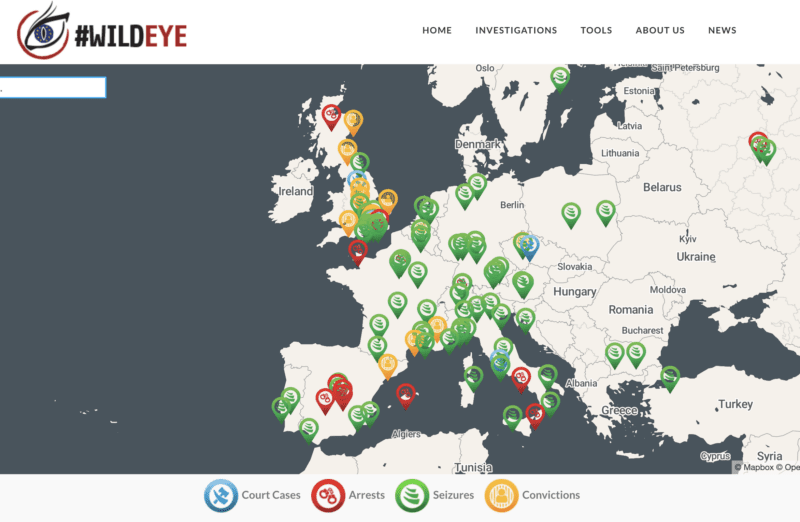Coverage of the illegal wildlife trade in Europe got a boost last month when the Earth Journalism Network joined forces with Oxpeckers Investigative Environmental Journalism for the launch of #WildEye, a new digital GeoJournalism tool that maps and tracks data on Europe’s role in wildlife trafficking.
The resource is the first of its kind to compile information all in one place on seizures, arrests, court cases and convictions related to wildlife crime in Europe.
Designed for use by journalists, policymakers and the general public, #WildEye uses search filters, tags, geolocation and custom online map-making to enable users to track law enforcement interventions that interest them. It is an open source tool, freely available to those who want to use and share it.
“Wildlife traffickers are increasingly active in Europe, which is growing in importance as both a transit hub and a market for illegally traded endangered species and their products,” says Oxpeckers’ editor Fiona Macleod.
Globally, the illegal wildlife trade is reported to be worth more than US$20 billion annually, posing threats to endangered species, such as rhinos and pangolins, and global ecosystems.
“Law enforcement agencies in many countries are working tirelessly to intervene in this illicit trade and to crack down on the syndicates involved. But it’s difficult to keep track of their actions and to monitor the impacts they are having,” Macleod explained. “#WildEye is a data-driven tool that makes this information easily accessible.”
At its launch on January 28, 2019, #WildEye featured more than 155 data points across greater Europe. The majority of incidents were seizures, followed by convictions, arrests and then prosecutions. Most of the incidents recorded took place in the United Kingdom, followed by France, Germany, Italy and Spain.
#WildEye is part of EJN’s Investigating Wildlife Trafficking project, which supports journalists to monitor and investigate wildlife trafficking in Europe and its related supply chains. The aim of these investigations is to examine the impact wildlife crime has on society, highlight solutions and identify gaps in laws and enforcement that allow illegal trafficking to thrive.
Through #WildEye data, journalists can find stories and analyze trends in the illegal wildlife trade (IWT). Their investigations then feed new data into the platform.
In addition, South Africa-based Oxpeckers is continuously updating and managing the map’s data, by engaging with a range of sources, including researchers, conservationists, data scientists, lawyers, government officials and law enforcement agencies.
Many of those sources have accessed the tool since it went live last month and say it can help paint a better picture of the trade.
“For too long, our understanding of IWT has been overly reliant on seizure data,” said Simone Haysom, a senior analyst at the Global Initiative against Transnational Organized Crime. “But seizures never seem ultimately to dismantle the illicit trade, giving the public a skewed perception of how the fight against IWT is going.
“The data that #Wildeye is capturing – about arrests, convictions, court cases – provides a rich new source of data, which can potentially tell us a lot more about the networks involved and the success of law enforcement to tackle them.”
That’s one objective Roxanne Joseph, #WildEye’s data manager, set out to accomplish in helping develop the tool.
“Now that we’ve finished the platform, we hope that organizations working in the field will use the data to explore and better understand the issues that are relevant to them, and the areas in which they work,” she said.
